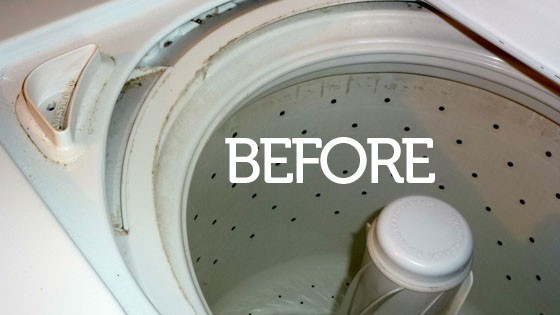Is your washing machine starting to smell less than fresh, or are you noticing residue on your freshly washed clothes? Just like any appliance that regularly deals with dirt and grime, your washing machine needs a good cleaning every now and then. Knowing how to clean your washing machine is essential not only for keeping your laundry smelling its best but also for the longevity and efficiency of your appliance. This guide will walk you through a simple, natural, and effective method to clean your top-loading washing machine using just a couple of common household ingredients.
Why Cleaning Your Washing Machine Matters
You might be wondering, “Why do I need to clean the washing machine? Isn’t it cleaning itself every time I run a load?” While your washer is designed to clean clothes, it can also become a breeding ground for bacteria, mold, and mildew if not properly maintained. Here’s why learning how to clean your washing machine is crucial:
- Eliminate Unpleasant Odors: Washing machines, especially High-Efficiency (HE) models, can trap water in certain areas. This trapped moisture creates a perfect environment for mold and mildew to grow, leading to musty and unpleasant smells that can permeate your laundry room and even transfer to your clean clothes.
- Prevent Odor Transfer to Clothes: If your washing machine smells, those odors can easily transfer to your freshly washed clothes. Nobody wants clean clothes that smell stale or musty! Regular cleaning ensures your clothes come out smelling truly fresh and clean.
- Remove Hard Water and Limescale Buildup: Hard water can cause mineral deposits and limescale to accumulate in your washing machine’s components and pipes. This buildup reduces efficiency, slows down water flow, and can eventually lead to costly repairs. Cleaning helps remove these deposits, keeping your machine running smoothly.
- Address Humid Climate Issues: If you live in a humid environment, your washing machine is less likely to dry completely between loads. This constant dampness encourages the growth of mold and mildew, leading to persistent stale odors and potential damage to the machine.
- Clean Soap Scum and Grime: Even with detergent designed to clean, soap residue and dirt can splash and accumulate on areas of the washing machine drum and agitator that are above the waterline. This grime needs to be cleaned away to maintain hygiene and prevent buildup.
The Natural Cleaning Power Duo: Vinegar and Baking Soda
Many conventional washing machine cleaners contain harsh chemicals like bleach, which are not only harmful to the environment but can also be corrosive and damaging to septic systems. Thankfully, you can effectively clean your washing machine using natural and readily available ingredients: white vinegar and baking soda.
- White Vinegar: Vinegar is a natural disinfectant that effectively kills mold and mildew.[1] Its acidity also helps to break down soap scum and dissolve mineral deposits from hard water buildup in your washtub and pipes.
- Baking Soda: Baking soda is a mild alkali that works as a gentle abrasive cleaner to scrub away soap scum and grime. It’s also a natural deodorizer, perfect for tackling those stinky washer smells.
This natural cleaning method is safe for septic systems and all washing machine components, offering a gentle yet powerful way to keep your appliance in top condition.
Step-by-Step Guide: How to Clean Your Top-Loading Washing Machine Naturally
Follow these simple steps to naturally and effectively clean your top-loading washing machine:
Step 1: Hot Water and Vinegar Wash
- Set your washing machine to the hottest water setting and the largest load size.
- Ensure the washing machine is empty – no clothes or detergent should be added.
- Pour 3-4 cups of white vinegar directly into the water-filled drum.
- Let the machine agitate for a few minutes to circulate the vinegar throughout the tub.
Step 2: Baking Soda Soak
- Add approximately ½ cup of baking soda to the washing machine drum.
- Allow the machine to agitate briefly to mix in the baking soda with the vinegar water.
- Stop the wash cycle and let the vinegar and baking soda solution soak in the washing machine for 30 minutes to 1 hour. This allows the mixture to penetrate and loosen grime, mold, and mildew.
Step 3: Scrub and Wipe Down
- While the soaking is in progress, prepare a cleaning solution by dipping a clean cloth or sponge into the vinegar water within the washing machine.
- Use this damp cloth to thoroughly wipe down all accessible parts of your washing machine. Pay special attention to:
- The top of the washing machine and the lid.
- Control knobs and panels.
- The top rim of the wash bin, which often accumulates grime above the waterline.
- Bleach and fabric softener dispensers – these areas can harbor residue buildup.
- For stubborn grime or tight corners, use an old toothbrush to gently scrub away dirt and buildup.
Step 4: Drain and Rinse
- Resume the wash cycle and allow the machine to run until it begins to drain the vinegar and baking soda solution.
- If your washing machine has a setting to drain while spinning, activate it. This helps to flush out loosened grime through the drum’s drainage holes. If not, simply allow the wash cycle to complete its drain and spin process.
- For an extra thorough rinse, you can run a second hot water wash cycle with just plain water (no vinegar or baking soda) to ensure all residue is removed.
Step 5: Final Wipe Down
- Once the final cycle is complete, use a clean, damp sponge or cloth to wipe away any remaining scum or residue, particularly around the top rim of the wash bin. This area may require a little extra attention as water doesn’t always reach it during the wash cycle.
- Leave the washing machine lid open to allow the interior to air dry completely. This helps prevent moisture buildup and the recurrence of mold and mildew.
Maintaining a Fresh and Clean Washing Machine
Once you’ve experienced the satisfaction of a freshly cleaned washing machine, you’ll want to keep it that way! Here are a few tips for maintaining a clean and odor-free washing machine:
- Keep the Lid Open: After each wash load, leave the washing machine lid open for a while to allow air circulation and prevent moisture buildup, which contributes to mold and mildew growth.
- Regular Cleaning Schedule: Depending on how frequently you use your washing machine and the humidity of your environment, aim to clean your washing machine using this natural method every few months, or whenever you notice odors or residue.
- Use Appropriate Detergent Amounts: Excessive detergent can lead to buildup in your washing machine. Use the recommended amount of detergent for each load to minimize residue.
- Consider Homemade Detergent: Switching to a natural, homemade laundry detergent can also reduce harsh chemical buildup in your machine.
By following these simple steps on how to clean your washing machine naturally, you can ensure your laundry comes out smelling fresh, your appliance runs efficiently, and you avoid the use of harsh chemicals. Share this guide with friends and family to help them keep their washing machines clean and their laundry smelling great too!
Sources
[1] Vinegar as a Disinfectant: Research and Evidence. (Note: In a real article, a specific credible source link or citation would be placed here).

